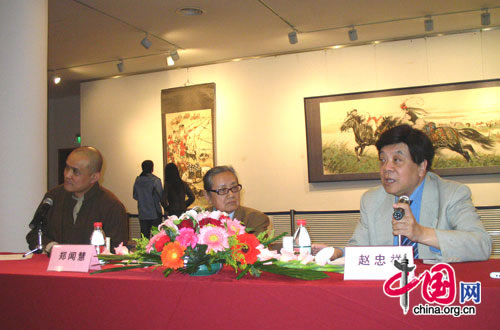Huang Zhou: shed light on Chinese painting
|
(From left to right) Huang Zhou's apprentice Shi Guoliang, Huang's wife Zheng Wenhui, and Huang's friend Zhao Zhongxiang [China.org.cn] |
A seminar about the artwork and life of late Chinese painting master Huang Zhou was held in Beijing at the Yanhuang Museum on October 21. Attendees included Huang's wife Zheng Wenhui, friend and former CCTV anchorman Zhao Zhongxiang, and apprentice Shi Guoliang.
Huang Zhou was born in a poor village in Hebei Province in 1925, and died 72 years later in 1997, having witnessed the development of new China. Unlike his predecessors such as Xu Beihong and Jiang Zhao, who had studied abroad and applied the precise anatomy approach to traditional Chinese painting, Huang learned from Chinese artists Zhao Wangyun and Han Leran, who added traditional Chinese cultural elements to painting. Shortly after Xi'an was liberated on May 20, 1949, Huang joined the People's Liberation Army to record the life and work of that period via paintbrush for a magazine.
Huang combined Western sketching skills and traditional Chinese painting to capture the movement of people and animals, which proved to be a huge success. His figure paintings depicted the vivid life scenes of Chinese ethnic groups and ordinary people, revealing a harmonious relationship between humans and nature. He led mainland Chinese painting to a new era.
According to Shi Guoliang, both Huang's apprentice and a monk, diligence was what led Huang to success. He never stopped painting, even when he was seriously ill. His practice sketches could fill numerous burlap bags. Huang's "half student and half friend" Zhao Zhongxiang said that history was another important reason for Huang's success. During that time, China desperately needed artwork to reflect the passionate and positive everyday life of the people, which he was able to portray. Huang worked hard after the Reform and Opening-up Movement in 1978, building several organizations such as the Academy of Chinese Painting and Yanhuang Art Museum to collect and show traditional Chinese paintings.
Talking about Huang's influence on the future of Chinese painting, Shi holds a dim view. He believes that with today's overwhelming influence of Western culture, many art students and artists have strayed too far from traditional Chinese art. Rather than paying attention to basic painting skills, they have pursued "the concepts and skills abandoned by westerners in the 1960s," and have produced too many meaningless "art experiments." However, Zhao Zhongxiang has a brighter outlook on the situation. He thinks the future of Chinese painting will be created by the few students who work hard. He said that with the development of Chinese society, Chinese culture will also gradually bloom, although it may take some time.
"The spirit conveyed in Huang's painting actually is a steady faith in beautiful life. I believe this spirit will be inherited," Zhao said.
The exhibition of Huang Zhou's works will be on display at the Yanhuang Museum until October 31.
 0
0 








Comments